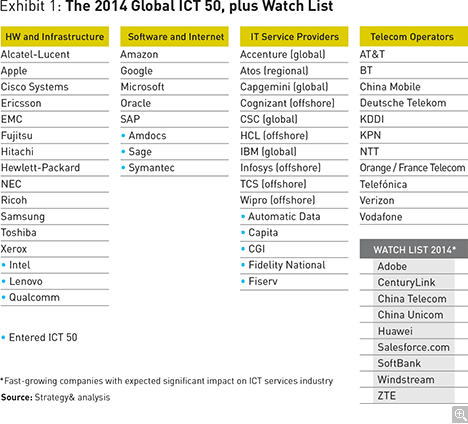Kings of the Cloud
The leading companies in the tech industry are reworking their business models to deliver everything-as-a-service.
The transition to a digitized business environment is happening with remarkable speed. Companies are gathering and analyzing huge amounts of data, transforming their manufacturing processes with digital fabrication and other technologies, and incorporating the Internet of Things in their products and processes (see “A Strategist’s Guide to the Internet of Things,” by Frank Burkitt). The companies at the forefront of these technology industry trends have already gained a competitive edge over their slower rivals.
A key factor has been the move to cloud computing. Virtually every large organization is using interconnected, shared infrastructure—comprising servers, software, connections, and information—in a utility-like fashion, connected over the Internet. Both public clouds (shared by customers) and private clouds (dedicated to one company) are rapidly increasing their power and prevalence. Without the cloud, it would be far more difficult for companies to gather, store, analyze, and use the mountains of data so critical to success today. And as cloud computing becomes ubiquitous, it affects just about every aspect of the information and communications technology (ICT) industry, the industry that makes business digitization possible.
Current technology trends are lowering the prices of IT services and software, and shifting them from outright purchases to flexible subscriptions. For the suppliers of digitization, this may initially push down IT revenues, but in the longer run it could lock in customer relationships, enable speedier customization of products and services, and intensify innovation and global expansion. The net effect may be to concentrate business further around the top few industry players, which will all offer cloud-based platforms at a massive global scale.
These trends are evident in Strategy&’s third annual analysis of the Global ICT 50, the leading providers of information and communications technology for enterprises. Each year, we analyze and rank the influence and business success of the 50 largest publicly held companies that supply digitization-related products, services, and infrastructure to businesses, governments, and other organizations around the world. Our goals are to provide the industry with a view of its strongest companies and to help large customers better understand their technological options, especially in building their own distinctive capabilities.
The Global ICT 50 rankings are based on a carefully weighted formula that takes four critical criteria into account: financial performance, portfolio strength, go-to-market footprint, and innovation and branding. We select the 50 largest public companies serving enterprises from four major sectors and rank them according to our criteria (see Exhibit 1). Because the Global ICT 50 rankings are weighted toward business-to-business activity, they tend to favor companies in that sphere. Major consumer-oriented companies, such as Apple and Google, tend to appear on the list, but not at the top. The sectors are:
• Hardware and infrastructure. Companies such as Apple, Cisco Systems, Hewlett-Packard (HP), and Xerox make the PCs, smartphones, tablets, routers, and telecom networking equipment that underpins our digital world. As their products become commoditized, many hardware makers are diversifying into software, services, and other businesses.
• Software and Internet. Companies such as Google, Microsoft, Oracle, and SAP produce programs, data systems, and Internet-based (increasingly cloud-based) services. This sector has seen considerable change; three of the eight companies on last year’s list have been replaced.
• IT service providers. These companies offer critical IT services, including network hosting, enterprise-level business application management, and hardware and software integration. There are three subcategories: Global service providers, such as Accenture, CSC, and IBM, serve clients around the world. Regional service providers, whose business is limited to local relationships, continue to struggle; five out of seven dropped off the 2013 list, replaced by a new five. Offshore service providers, including HCL, Infosys, and Wipro, are mostly based in India but offer their wares worldwide. They continue their long and robust expansion into new markets.
• Telecom operators. Companies such as AT&T, NTT, and Vodafone offer a variety of communications services—including fixed and mobile voice and broadband, and often Internet-based television.
This year’s results suggest that competition in the ICT industry is much more difficult than it was even 12 months earlier. Enterprise customers for hardware, software, and services have more options and are becoming more sophisticated in linking their technology purchases to strategy. Consolidation is also having an effect: For example, although telecommunications companies continue to struggle for growth, their profitability is improving after a year of mergers and acquisitions. Global reach, in the form of a broader geographic footprint, is becoming a prerequisite for success in this industry, particularly in services.
Most important, activity is rapidly migrating to online interconnected computing resources. The top competitors in the Global ICT 50—particularly the top five, which are IBM, Microsoft, SAP, Oracle, and Cisco Systems—might not have been considered one another’s direct competitors a few years ago (see Exhibit 2). Now they offer a number of similar products and services, all with an increasingly cloud-centered portfolio. Elsewhere on the Global ICT 50 list, companies with a cloud orientation are moving up, while others move down or even drop off the list. The industry leaders are seeking dominant positions, wanting to become the kings of the cloud. As a group, they are putting distance between themselves and the second tier of followers.
The top competitors in the Global ICT 50 are offering similar products and services, all with a cloud-based portfolio.
Changing Currents
On the surface, the Global ICT 50 list might seem relatively stable, especially for its highest-ranked companies. Only two firms moved out of the top 15 this year. Atos, a services firm based in Europe, lost ground to companies with broader geographic markets, and Adobe dropped all the way out of the top 50 because of a steep one-time decline in revenue following its shift from a licensing to a subscription software model. Its revenues are expected to revive soon, at which point it will likely rejoin the list. Replacing those two in the top 15 were EMC, a U.S.-based cloud storage and services company (and the fastest-rising among the top 15), and HCL, an offshore IT services firm, which is also rapidly moving into cloud-based services.
Nonetheless, a full 22 percent of the list is different from last year’s. A few well-known global companies slipped off, including Adobe (as noted), BlackBerry (RIM), Dell (because it is no longer a public company), and Yahoo. Companies joining the list include Intel, Lenovo, Qualcomm, and Symantec (see “Lenovo Goes Global,” by William J. Holstein, s+b, Autumn 2014). We also keep a watch list of companies whose rapid growth suggests they could be contenders for future lists. These include the Japanese telecommunications firm SoftBank; four Chinese companies (Huawei and ZTE [hardware] and China Telecom and China Unicom [telecom]); and four U.S. companies (Adobe, Salesforce.com, and two telecom companies that provide Internet-based services, CenturyLink and Windstream Communications).
The financial picture also indicates significant underlying change. Together, the companies that make up this year’s Global ICT 50 posted US$2.22 trillion in revenues, 2 percent more than they did the year before, while the companies’ average profit margin stayed stable, at 15.4 percent. Software and Internet companies, as usual, performed disproportionately well, with revenues up 11 percent, to $284 billion. But their margins, although the strongest of any category, were down from the previous year—from 25 percent to 22.5 percent of revenues. This supports the conclusion that the ascending products and services, such as cloud computing and other subscription-based services, don’t produce the earnings that license-based services have in the past.
The hardware and infrastructure sector experienced respectable growth in revenues this year, reaching $858 billion, up 3 percent from the prior year, but margins overall have not improved at all in what is increasingly a commodity business. Most of the companies in this category made little or no profit. The exceptions included Apple, which captured more than 40 percent of the profits in smartphones and tablets, and Samsung, Intel, and Cisco, which each had profits of more than $10 billion.
Given maturing markets and legacy technologies, it isn’t clear how well the IT services sector can keep up with the changing market—particularly the move to the cloud, which makes some traditional outsourcing offerings less relevant. As for telecom, although its profit margins rose in 2014 by 3 percentage points, to 18 percent, the reason probably had to do with short-lived events: consolidation and cost-oriented restructuring efforts. The boom in mobile telephony helped revenues, but at the same time competition intensified. If you are a telecom company leader, this is not a time for complacency.
The data on geographic footprints shows the increasing importance of global expansion. Among the service providers, for example, global companies are thriving most, thanks to their ability to apply their capabilities around the world. Some are operating massive hubs in low-cost labor centers such as India. The offshore IT services players are similarly broadening their footprint, aggressively buying up market share in mature, high-spending markets. Their footprints remain small, much smaller than those of the global giants, but with strong momentum. Telecom companies remain tied to their investments in local infrastructure, but the cloud makes it easier for global competitors to move in.
ICT growth in emerging markets has slowed, particularly as economic growth has peaked in countries such as Brazil, India, and Russia. China is still a major ICT purchaser, on a par with Japan, but ICT market activity is shifting to mature economies, at least in the short term, as organizations convert their legacy IT systems to the cloud.
The final component in our ranking involves the relative strength of the companies’ innovation efforts and the value of their global brands. In 2014, six of the 10 most innovative companies from the Strategy& Global Innovation 1000 study were also in the top 15 of the Global ICT 50: Amazon, Apple, Google, IBM, Microsoft, and Samsung. This is significant because the Global Innovation 1000 contains companies from all industries. There is also some correlation with Interbrand’s 2013 study of brand reputation, which placed six Global ICT 50 companies among its top 10 global brands: Apple, Google, IBM, Amazon, Microsoft, and Samsung.
Fighting for the Cloud
All five of the top-ranked Global ICT 50 companies appear to be basing their future on cloud computing. They have invested heavily in it, through innovation and M&A, and this has given each of them an advantage in scale and scope. If the ranking criteria (financial performance, portfolio strength, go-to-market footprint, and innovation and branding) are, as we believe, accurate predictors of digitization impact, then IBM, Microsoft, SAP, Oracle, and Cisco Systems could become the pacesetters of cloud computing, competing to bring enterprises a new level of proficiency.
IBM has been an active proponent of migration to the cloud. Starting with its “on-demand” offerings in the early 2000s, it has filed more than 1,500 cloud-related patents, and has made at least 15 cloud-related acquisitions valued at more than $7 billion. In 2013, it took in $4.4 billion in cloud-based revenue, up 69 percent from the prior year.
IBM’s offerings for the cloud include infrastructure-as-a-service (IaaS) for underlying storage and computing capacity, platform-as-a-service (PaaS) for application development and deployment, and software-as-a-service (SaaS) for serving end-users within enterprises. Together, these represent one of the company’s three main strategic imperatives. The others are big data and analytics, and enterprise mobility. The cloud is particularly critical to the company’s strategy, because it provides the underpinning fabric that makes the other two imperatives possible.
Microsoft is similarly intent on migrating its enterprise infrastructure and application business to the cloud. Despite the challenges this company has encountered on the consumer-facing side of its business, it is extremely successful overall. The enterprise division, which is made up of the servers, cloud computing, and programming tools businesses, represents almost half of Microsoft’s total $80 billion in revenue, and almost two-thirds of its $60 billion in gross earnings.
The firm is expanding its cloud-based software-as-a-service business, which has consistently had double-digit annual growth or better, and which currently has more than $1 billion in annual revenues. The two-year-old cloud-based Office 365 offering has also been successful, more than doubling its revenue in its second year. Microsoft’s other cloud-based offerings include Azure (IaaS) and customer relations management; it competes directly with the category leader, Salesforce.com. The company’s well-established capability for building relationships with IT professionals is a critical strength. Its brand is ranked number five by Interbrand, and it has more than $80 billion in cash to help it fight the battle for the cloud.
SAP, which offers enterprise computing infrastructure, data analytics, and software platforms tagged to industry verticals, is a relative latecomer to the cloud. It began the transition around 2012, with help from the acquisition of the human capital software company SuccessFactors. SAP recently announced the creation of a new business unit devoted to cloud-based products for vertical industries, including the Internet of Things and e-health offerings.
SAP’s move into the cloud has led to a growth rate of 60 percent in cloud-based revenues in early 2014, even as it plans to maintain its slower-growth but higher-margin non-cloud business. In the Global ICT 50, the company is currently ranked number three in its subsector in financial health, and, should its combined cloud and non-cloud plan work out, it should maintain or even improve that ranking.
Oracle was both early and cautious in moving to the cloud. It introduced its CRM On Demand offering in 2006, and made a number of high-profile, cloud-relevant acquisitions: J.D. Edwards, PeopleSoft, Sun Microsystems, and, more recently, Responsys, a provider of cloud-based B2C marketing software. Oracle ranks first among the Global ICT 50 in portfolio strength, and its cloud services are increasingly responsible for this, especially in private systems tailored to individual companies. It is launching its own cloud-based database platform to compete with similar offerings from Amazon and others.
But Oracle also lags behind its rivals in offering cloud-based CRM, SaaS, and office productivity solutions. Just 3 percent of its 2013 revenue was derived from its cloud offerings; its success has largely depended on providing database and CRM software through a non-cloud, premises-based model. It is reframing its software portfolio as an enterprise app store, letting customers decide whether to go the cloud route or maintain their existing system behind its corporate firewalls. Whether it decides to more tightly integrate all of its acquisitions into a full-service cloud offering for enterprises remains to be seen.
The fifth-ranking company, Cisco Systems, takes a distinctive approach. Rather than offering cloud services directly to enterprise end-users, it provides them with the infrastructure and platforms needed to build computing clouds themselves. Cisco isn’t the first entrant into this market, but according to the Synergy Research Group, it sells more of the hardware on which the cloud is based than does any other player. It also emphasizes integrated solutions; for example, Cisco’s Unified Data Center and UCS IaaS products unite computing, networking, storage, management, and virtualization into a single system oriented to improve operating efficiencies.
Given this focus on selling underlying components—especially networking hardware and servers—it is natural for Cisco to pursue an open, standards-based approach. Its goal is to help customers avoid being locked into a single vendor or platform—while relying on Cisco, of course, for a good share of the technology. Cisco has a long history of supercharging its innovative capabilities through strategic acquisitions. It has acquired more than 170 companies since 1993. Over the next two years, it plans to invest more than $1 billion to build its expanded cloud business. Thanks to its strong cash position, it can afford to keep building out its portfolio. It will probably become a key enabler of the growth of the Internet of Things.
Consolidation and Competition
What are the implications for companies in the technology industry? This year’s study shows just how competitive and concentrated the industry has become. The battle for a share of the cloud services market is fierce, but the same can be said for providers of big data and analytics, social media, and, increasingly, the Internet of Things. Size matters, too, especially when selling to large corporations—as IBM’s number one spot in the rankings this year demonstrates. And the fact that all of the top five Global ICT 50 companies are growing their businesses aggressively through acquisition suggests the importance of building complete portfolios quickly.
But no single technology provider can be all things to all enterprises, and there are plenty of profitable niches to be found in the market. Success will come to those ICT companies that focus on a distinctive edge, finding a combination of capabilities and product portfolios that best enable them to pursue their chosen strategy.
The greatest opportunity in this story is for the technology users; the companies that purchase ICT and use it to serve their customers in their own distinctive ways. The rise of the cloud has leveled the playing field, broadening access and lowering costs for many types of ICT offerings. Specialized access to enterprise ICT is becoming a commodity; small companies can benefit from the same services as industry leaders. Cloud-based services can build on modular designs to create unique capabilities that fulfill their own strategies, without having to replicate the functions, or the best practices, of their competitors. Technology can now more easily be a vehicle for strategic choice: a way to determine what a company can do best, and to put that understanding into practice. The information and communications technology providers that realize this, and make it more feasible through their offerings, will be the leaders of the Global ICT 50 for many years to come. ![]()
Reprint No. 00285
Author profiles:
- Olaf Acker is a partner with Strategy& based in Frankfurt and Dubai. He focuses on business technology strategy and digital operating model transformation programs for global companies in the telecommunications, media, and technology industries.
- Germar Schröder is a partner with Strategy& based in Frankfurt. He focuses on communications clients and ICT service providers, and has led several initiatives for product development, go-to-market, and operating model design, specifically for the cloud.
- Florian Gröne is a principal with Strategy& based in New York and Berlin. He works with communications, media, and technology companies on new customer experiences, products, and services, and building operating and technology models for the digital age.
- Also contributing to this article were Strategy& senior associate Florian Muhss, associate Markus Weiss, and s+b contributing editor Edward H. Baker.
- This article is based on the third annual Strategy& Global ICT 50 study. For the full report, the methodology, and previous years’ studies, see www.strategyand.pwc.com/2014-ICT50.






